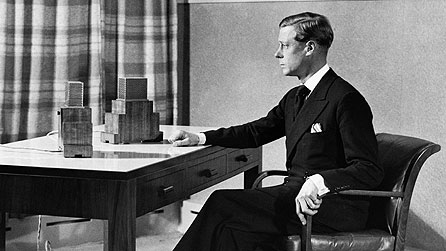
Everybody was new at this. Royalty meeting members of the public at such close range hadn’t really happened much before. The organizers of the meeting, however, went so far as to paint a white line on the grass – like marking side lines on a football field – to keep the planned inspection orderly. Two Royal family members walked on one side of the painted line, and members of the military being inspected stood on the other, including a Royal Air Force pilot named Dave Shannon.
“It’s Flight Lieutenant Shannon’s 21st birthday,” his commanding officer told the King and Queen as they paused before him.
“You seem to be a very well preserved 21,” King George VI told Shannon. “You must have a party tonight.”
The King could probably have spoken for the entire British Commonwealth that day, three-quarters of a century ago.

A few days earlier, May 17, 1943, Shannon and 133 members of the famous “Dam Busters” bomber squadron had just returned from an attack on the hydroelectricity dams that powered Nazi weapons factories in Germany’s Ruhr River valley. The aircrews from four Allied nations, including Canada, had successfully breached two of the dams and damaged a third.
And King George and Queen Elizabeth (the Queen Mum) felt it absolutely critical to meet and congratulate the surviving members of that squadron to tell them they had likely turned the tide in the Second World War. For George and Elizabeth it was seminal.
Not so critical, at least not to me, will be the Royal wedding and reception that takes place two days from now. Sometime in the hours long before I choose to rise on Saturday morning, Prince Harry and Meghan Markle will be married in St. George’s Chapel at Windsor Castle.
I’m not anti-monarchy. I don’t want to rain on their reign as Royals-of-the-week. I just choose to pay attention to regal figures and their activities when, again in my view only, they appear to have some relevance. I admire Royals who rise to heights greater than they.

I’ll start with Harry’s mother, Lady Diana Spencer. Yes, 750 million people tuned in to watch her marry Prince Charles in July 1981, and the world stopped when she died in that Paris car crash 16 years later. But I prefer to remember Princess Diana’s visit to the Harlem Hospital Center in 1989, when she spontaneously hugged a seven-year-old child with AIDS. As relevant (and perhaps leaving an impression deeply enough on son Harry who later championed the Invictus Games) Diana visited the families of British soldiers in the Gulf War. She set the Royal bar higher with her sense of action for women’s equality and service to humanity, not Royal watchers.
“When she sat on the bed of a man with HIV/AIDS,” President Nelson Mandela said after Diana’s death, “she transformed public attitudes.”

Most people didn’t think much of King George VI’s brother, Edward VIII. After all, he sat on the throne mere months in 1936, when he sparked a constitutional crisis because he decided to marry Wallis Simpson, a commoner, an American, and a divorcée! For me, however, Edward’s decision to abdicate the throne and inform his subjects and the world not in a proclamation, but in a public broadcast to the U.K. on the British Broadcasting Corporation, was a unique piece of history – social history and broadcast history.
“I have found it impossible to carry the heavy burden of responsibility and to discharge my duties as king as I would wish to do,” he said in a live BBC announcement on Dec. 11, 1936, “without the help and support of the woman I love.”
But British Kings and Queens – like all royalty, I guess – are supposed to lead and inspire their subjects. And I come back to this week 75 years ago. Though George and Elizabeth didn’t know it, it was roughly the midpoint of the war in Europe. It truly was their darkest hour. The wartime Royals had witnessed the horrific retreat at Dunkirk, the Battle of Britain, and the devastation of the Blitz.
On one night in 1940 alone German bombers had dropped 224 tons of high explosive and 279 incendiary cannisters on London, including the inner quadrangle of the Royal Chapel at Buckingham Palace. Later, the Royal couple had toured streets of London’s East End.
“I felt as if I was walking in a dead city,” the Queen Mum wrote. “All those houses evacuated with possessions, photographs, beds, just as they were left.”

But suddenly on May 17, 1943, these incredible 133 airmen from across the Commonwealth had delivered a devastating blow to the Nazi war machine. And walking along that white painted line at the RAF Scampton airfield the Queen and King offered homage to those killed in the raid, and congratulations to the survivors for helping to lead a Commonwealth and its monarchs out of their darkest days.
And they said so by visiting the Dam Busters 75 years ago this month. Not just reigning over subjects, but truly serving them.